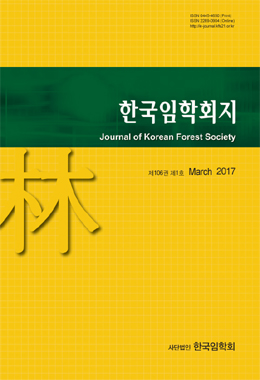본 연구에서는 느티나무, 물푸레나무 및 졸참나무를 대상으로 시설양묘 과정에서 요구되는 적정 용기의 생육밀도 및 용적을 구명하고자, 16 종류의 용기[4 생육밀도(100, 144, 196, 256본/㎡)×4 용적(460, 380, 300, 220 ㎤/구)]에서 생산된 용기묘의 생리 특성을 조사·분석하였다. 생육밀도 및 용적에 따른 용기묘의 광합성 특성, 광화학 효율 및 엽록소 함량 변화를 알아보기 위해 이원분산분석과 다중회귀분석을 이용하였다. 세 수종 모두 용기의 생육밀도와 용적은 묘목의 광합성 기구에 영향을 미치며, 두 요인간의 상호작용이 졸참나무의 기공전도도를 제외하고 광합성 속도, 수분이용효율, 기공전도도 및 엽록소 함량에서 확인되었다. 그러나 광화학 효율은 생육밀도와 용적에 따른 상호작용이 없었다. 또한, 물푸레나무와 졸참나무의 광합성 속도는 생육밀도와 부의 상관관계를 보였으며, 세 수종 모두 광합성 속도와 용적과는 정의 상관관계를 보였다. 광합성 속도를 기준으로 다중회귀분석기법을 적용한 결과, 느티나무는 160~210본/㎡과 430~460 ㎤/구, 물푸레나무는 130~150본/㎡과 390~440 ㎤/구, 졸참나무는 130~170본/㎡과 420~460 ㎤/구가 최적 용기 규격으로 판단된다. 향후, 수종별 적정 용기 적용으로 양묘과정에서 우량 용기묘 생산뿐만 아니라, 조림 후에도 우수한 생장을 기대할 수 있다.
The purpose of this study was to evaluate the effects of container types on physiological characteristics of Zelkova serrata, Fraxinus rhynchophylla and Quercus serrata in the container nursery stage. We used 16 container types [4 growing densities (100, 144, 196 and 256 seedlings/㎡)×4 cavity volumes (460, 380, 300 and 220 ㎤/cavity)] and performed two-way ANOVA to test the differences in photosynthesis, photochemical efficiency and chlorophyll content among container types. Also, multiple regression analysis was conducted to correlate container dimensions with photosynthetic rate. Container types had a strong influence on photosynthesis of three species seedlings. Growing densities and cavity volumes had a significant interaction effect on photosynthetic rate, water use efficiency, stomatal conductance and chlorophyll contents except stomatal conductance of Q. serrata. In all three species, however, interactions between the two factors of container type were not found with regard to photochemical efficiency. Growing density was negatively correlated with photosynthetic rate of F rhynchophylla and Q. serrata, while cavity volumes positively affected on those of three species seedlings. The range of optimal container types was determined by multiple regression analysis based on photosynthetic rate. Consequently, optimal growing density and cavity volume of container by each tree species were found to be approximately 160~210 seedlings/㎡ and 430~460 ㎤/cavity for Z. serrata, 130~150 seedlings/㎡ and 390~440 ㎤/cavity for F. rhynchophylla and 130~170 seedlings/㎡ and 420~460 ㎤/cavity for Q. serrata, respectively. Application of adequate container will induce higher quality seedling production in nursery stage, which will also increase seedling growth in plantation stage.




